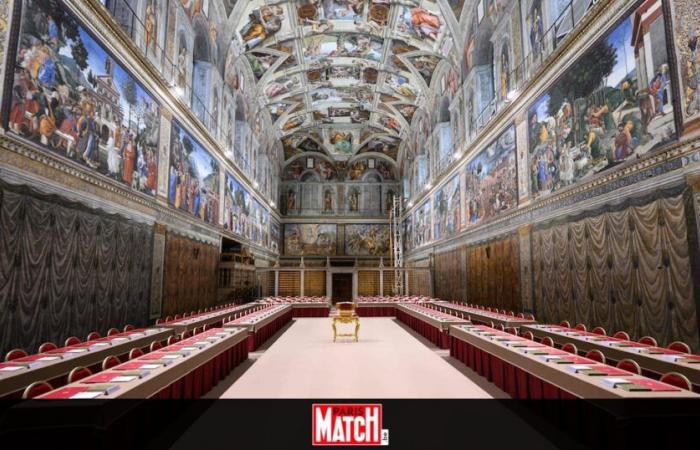
This Wednesday morning, one hundred and thirty-three cardinals, aged on average of 70 years and mainly appointed by pope Francis, will therefore meet to elect his successor. On the morning of the first day, they are asked to arrive at 9:15 am at the Saint-Sébastien chapel, where the tomb of John Paul II is located, to put on their liturgical outfit. This chapel is in the basilica, near the famous Pietà de Michel-Ange. They will participate at 10:00 am in a solemn mass in the Saint-Pierre basilica.
The cardinals move into the Vatican on the eve of the conclave in strict conditions: “There are at least five personalities who can be elected”
In the afternoon, at 4:15 p.m., they will meet in the Pauline chapel. The cardinals of the Latin church wear, according to the Vatican, a “red dress with belt, rock (a short dawn, editor’s note) Mosette (a short pilgrim), pectoral cross with red and gold cord, ring, cap and bar”, while those of the oriental churches are dressed with their own ecclesiastical costumes. In the song of the Litania of the Saints, they then enter into procession in the Sistine Chapel, whose isolation is scrupulously controlled.
After the last liturgical song, Veni Creator, the cardinals take oath. According to an immutable ritual inherited from the Middle Ages, the Master of the celebrations pronounces the “extra omnes” formula (all outside). Those foreign to the votes leave.
Election as such
By drawing lots, three cardinals are appointed “scrupoters”, three “infirmiii” to collect the votes of the sick cardinals and three “revisers” who check the bulletins by the scruttors. Sitting side by side under the monumental fresco of the “Last Judgment” painted by Michelangelo, the cardinals receive bulletins of rectangular paper carrying the inscription “Eligo in Summum Pontificem” (“I elis like Sovereign Pontiff”) with an empty space below. The voters write by hand the name of their candidate, “of a writing not recognizable”, and then fold the ballot twice. In theory, it is forbidden to vote for yourself.
-“If I am elected, I run away in Sicily”: this cardinal absolutely does not want to become a pope
Each cardinal in turn goes to the altar, carrying his vote in the air so that he is clearly visible, and pronounces aloud the following oath in Latin: “I take witness to the Christ Lord, who will judge me, that I give my voice to that which, according to God, I think I should be elected.” He then deposits his bulletin on a tray and makes him slide in the ballot box, in front of the scrupters, bowed to the altar and returns to his place. If no cardinal has obtained two thirds of the votes, the voters pass directly in a second round.
With the exception of the first day, the cardinals proceed to four ballots per day, two in the morning and two in the afternoon until a pope is proclaimed. After three days without result, the ballot is interrupted “for a maximum day, in order to give way to prayer” and “to free trade between voters”. Alas, we will never know the details of the votes. The bulletins are destroyed, burned in a stove. The fireplace, visible by the faithful from Saint-Pierre square, emits black smoke if no pope has been elected and white smoke in the event of an election, by adding chemicals. The bells of the Saint-Pierre basilica sound to announce the news. A new pope is elected.
Rebound in the election of the new pope: two cardinals will miss the conclave
He will then have to answer two questions from Cardinal Doyen: do you accept your canonical election as a sovereign pontiff? What name do you want to be called? Responding “yes” to the first, the elected official becomes immediately Pope and bishop of Rome. One by one, the cardinals pay tribute and mark their obedience to the new pope. Then come the announcement to the faithful -the famous “Habemus Papam” -by the cardinal protodiacre -he is French, the French cardinal Dominique Mamberti -, then the appearance of the new pope and his apostolic blessing Urbi and Orbi from the Balcony of the Saint -Pierre Basilica.







